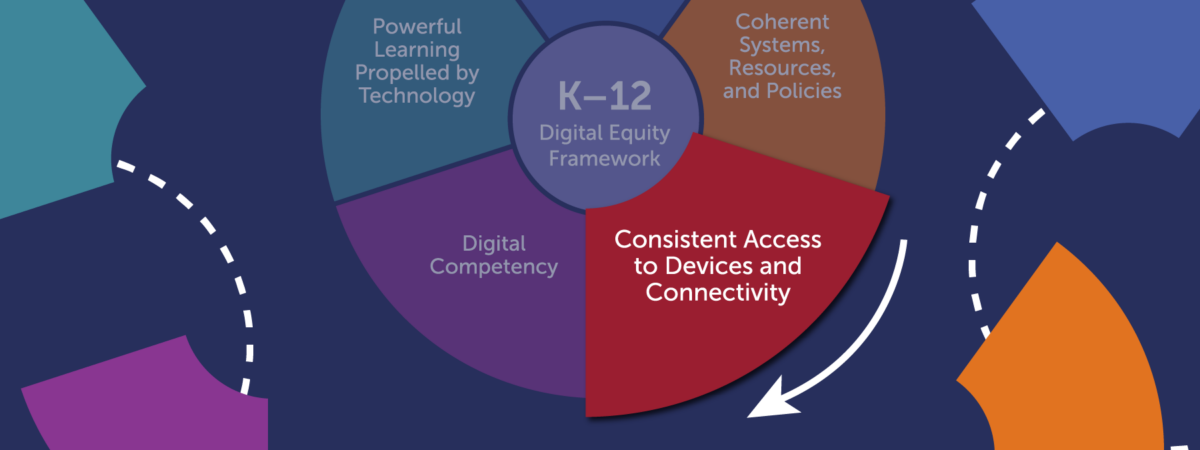
Without a strong digital infrastructure, students will continue to face barriers in accessing essential technology, creating disparities in educational opportunities. As you assess your current digital infrastructure, consider whether your systems are sustainable, adaptable, and equitable. Are all students receiving the same level of access? Are your devices up to date? How robust is your cybersecurity plan?
Although complex terminology might make this concept appear complicated, it is actually quite simple. Here are five key systems that support a successful digital infrastructure:
Device deployment is the process of getting technology into the hands of students and educators. Schools with a well-structured, equitable plan for deploying devices and other technology tools can greatly enhance their integration and support for Powerful Learning, both in and out of the classroom. “One of the most important things in order to be able to have a successful [device] rollout is to prepare and be organized,” said Debbie Bermeo Boswell, the Verizon Innovative Learning Schools technology coach at John A. Sutter Middle School in Los Angeles. “You have to meet with your team.” Key considerations include device storage, distribution logistics, and ensuring devices are ready for use.
Once devices are deployed, they need to be tracked, maintained, and monitored. Excellent device management ensures that updates, security patches, and software installations happen consistently, and provides ongoing tracking structures that support keeping technology functional and safe. It is important for school leaders to collaborate with IT device support personnel to strengthen the use of management systems to facilitate consistent, impactful implementation. By effectively utilizing management systems, schools can ensure consistent access to devices, and analyze usage patterns to optimize sustainability and effectiveness in the classroom.
Even the best technology can run into problems. Device support includes troubleshooting, repairs, and technical assistance that minimize disruptions in learning. School leadership teams alongside technical support personnel play a critical role in responding to issues quickly so that students and educators can stay focused on education rather than tech problems. Strengthen your in-house device support by empowering students as a part of a student tech team to assist when device issues arise. The student tech team is “not just part of our device care maintenance, inventory, and troubleshooting plan—they ARE the plan,” said Maria Montero, former assistant principal at Mater Academy Charter Middle/High School.
Fast and reliable internet access is essential for modern education, yet disparities in connectivity persist. Network infrastructure—including WiFi access points, routers, and broadband connections—forms the backbone of high-speed internet in schools. A strong, future-ready network ensures that digital learning tools remain accessible to all students, regardless of location or circumstance.
“Our students in grades 5-8 who have iPads through our partnership with Verizon [Innovative Learning Schools] can take their work home and continue learning, regardless of their home internet situation,” said Brandon Kash, director of technology for Duquesne City Public Schools. “This not only supports students but also makes teaching easier inside the classroom.”
Investing in robust network infrastructure is key to closing the digital access divide and ensuring equitable learning opportunities for every student.
With the growing reliance on technology and the increasing complexity of digital systems, cybersecurity planning is more critical than ever. Protecting student data, preventing cyber threats, and ensuring safe technology use are essential components of digital security. Schools must implement strong policies and tools to safeguard against breaches and maintain trust in their digital environments. As Diane Doersch, Digital Promise’s senior director of information security, emphasizes, “All students deserve to learn how to be safe on the internet, and by starting to teach cybersecurity early, we hope they will gain the confidence and skills needed to stay safe online.” By prioritizing cybersecurity education and proactive protection, schools can create a safer, more resilient digital learning environment.
Guaranteeing access to technology and reliable high-speed internet for all learners is an indicator of the Digital Equity Framework’s Consistent Access domain. By strengthening these five key systems, schools can create a powerful digital ecosystem that supports both students and educators, ensuring that technology enhances learning rather than hindering it.
Learn more about all five domains of Digital Promise’s Digital Equity Framework, and see how Consistent Access is put into practice in Verizon Innovative Learning Schools—this fall, 34 schools will join the program’s 12th cohort, which was just announced.